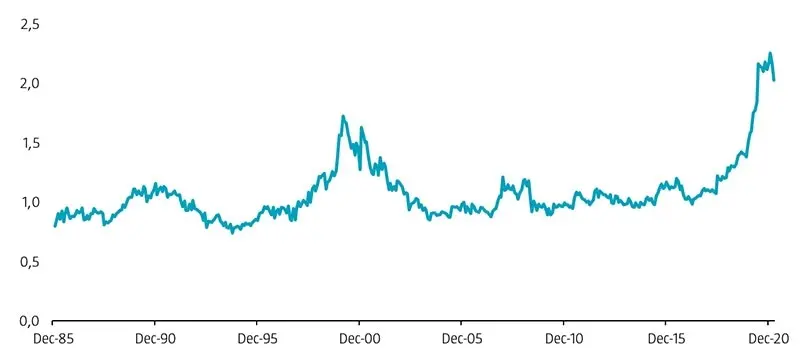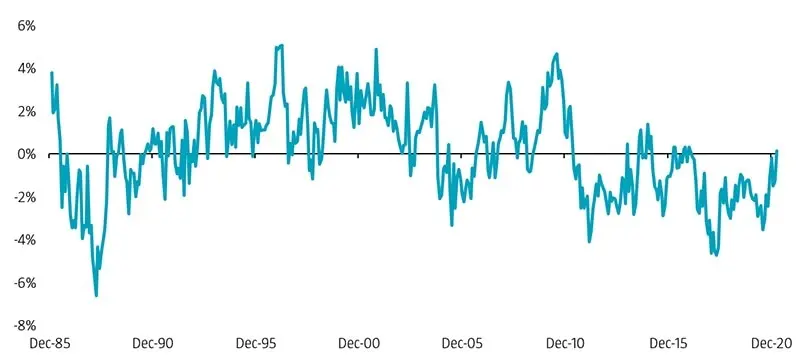The long-awaited value comeback was triggered by the announcement of successful Pfizer-BioNTech Covid-19 vaccine candidate results on 9 November 2020. This culminated in strong returns for the value factor in the first quarter of 2021. Despite this rally, the spread in valuation multiples between expensive and cheap stocks remains at exceptionally high levels. Indeed, Figure 1 shows that the gap has surpassed levels last seen at the height of the tech bubble in the late 1990s, based on an enhanced value factor.1
Figure 1 | Composite valuation spread for the enhanced value strategy

Source: Refinitiv. The figure shows the composite valuation spread between the top and bottom quintile portfolios of the enhanced value strategy. The investment universe consists of constituents of the MSCI Developed and Emerging Markets indices. Before 2001, we use the FTSE World Developed index for developed markets (going back to December 1985), and for emerging markets, the largest 800 constituents of the S&P Emerging BMI at the semi-annual index rebalance (going back to December 1995).
“
Value investing remains very attractive from a valuation perspective
In our view, this recent widening in multiples has several implications. First, diverging valuation multiples between cheap and expensive stocks are inconsistent with the concern that the value premium may have been arbitraged away as a result of it being so well known and due to substantial funds being invested in value strategies. Were this the case, it would be reflected in a narrowing valuation spread over time instead of the widening trend we have witnessed. Therefore, it is highly unlikely that arbitrage activity was the driver of the recent underperformance of value strategies.
Second, diverging valuation multiples suggest that return prospects for value are currently high. The widening of the valuation spread in the late 1990s was followed by mean reversion in the early 2000s, which resulted in the massive outperformance of cheap stocks over their expensive counterparts.
Third, the net spread widening that occurred over our full sample period means that realized returns might even underestimate the true magnitude of the value premium over this period.2
When we look at the recent developments in Figure 1, we do see that the value spread has shrunk slightly in 2021. However, it remains considerably wide compared to historical levels, still above the 97th percentile. Therefore, we believe that value investing remains very attractive from a valuation perspective.
The ‘cheap for a reason’ tag does not hold
One question that remains is that maybe ‘this time is indeed different’ and value stocks deserve to be cheaper than historically observed. Maybe expensive companies (based on simple valuation multiples) could be much more profitable today than in the past (compared to the dot-com bubble, for example), or their expected long-term growth could be much higher.
Figure 2 shows the spread in operating performance (proxied by gross profitability, GP/A)3 between cheap and expensive companies. On average, cheap stocks – according to the enhanced value strategy – display about the same levels of profitability as expensive ones, at a global level.4
Admittedly, cheap stocks have been less profitable between 2017 and 2020. However, their profitability has improved considerably in recent months. In fact, cheap stocks were actually slightly more profitable than their expensive peers at the end of March 2021. Therefore, the current valuation spread cannot be justified by differences in profitability.
Figure 2 | Spread in gross profitability for the enhanced value strategy

Source: Refinitiv. The figure shows the spread in gross profitability between the top and bottom quintile portfolios of an enhanced value strategy. The investment universe consists of constituents of the MSCI Developed and Emerging Markets indices. Before 2001, we use the FTSE World Developed index for developed markets (going back to December 1985), and for emerging markets, the largest 800 constituents of the S&P Emerging BMI at the semi-annual index rebalance (going back to December 1995).
Moreover, current profitability is mainly backward-looking, so what about future growth expectations? If profitability levels are the same as those in the present day, then stocks with higher expected growth should trade at higher valuations.
Cheap stocks tend to have lower future growth expectations than expensive ones, which explains why the latter are also called ‘growth stocks’. However, relative growth expectations are currently not lower than they have been in the previous 15 years, especially for developed markets. Thus, the widening of the value spread over the last three years cannot be traced back to a deterioration in growth expectations for value stocks.
Market sentiment for Value receives a shot in the arm
The recent value recovery has led to a change in sentiment regarding value stocks. Price momentum – measured as a stock’s return over the last 6 to 12 months – is one way to gauge market sentiment. While value and momentum tend to be negatively correlated – therefore providing diversification benefits – there have been a few periods in history when value stocks exhibited strong momentum. We expect this to happen again in the coming months.
Figure 3 depicts the difference between the median six-month performance of value and growth stocks. The difference has shifted from very negative to positive over the few last months. Since most momentum strategies use price momentum measures over 6 to 12 months and the value turnaround only started about six months ago, they have yet to purchase value stocks significantly. But one should expect them to start buying value stocks in a larger scale now that the market regime shift is clearly reflected in price momentum metrics.
Figure 3 | Spread in Momentum (6-0) for the enhanced value strategy

Source: Refinitiv. The figure shows the spread in 6-0 month price momentum between the top and bottom quintile portfolios of an enhanced value strategy. The investment universe consists of constituents of the MSCI Developed and Emerging Markets indices. Before 2001, we use the FTSE World Developed index for developed markets (going back to December 1985), and for emerging markets, the largest 800 constituents of the S&P Emerging BMI at the semi-annual index rebalance (going back to December 1995).
“
Current sentiment is in favor of value
Another way of measuring sentiment is to look at analyst earnings estimate revisions. Analysts tend to issue more upward than downward earnings revisions for expensive stocks than for cheap ones. However, over the last few months, analyst earnings per share (EPS) revisions for value stocks have been as optimistic as they have ever been in recent history. Although we still have to see if analyst earnings expectations will play out as forecasted, current sentiment is in favor of value.
All in all, after a long and harsh quant winter, spring has sprung and value seems ready for summer.
Footnotes
1 The enhanced value strategy is based on a composite of book-to-market (R&D adjusted), EBITDA/EV, CF/P, and NPY. Value stocks are sorted into quintile portfolios based on the valuation composite and in a region and sector respectively country neutral manner for developed and emerging markets. Quintile portfolios are equal-weighted and reformed monthly. The details of the enhanced value strategy are described in Blitz, D., and Hanauer, M., January 2021, “Resurrecting the Value Premium”, Journal of Portfolio Management.
2 Please see also the analysis in our paper ‘Resurrecting the Value Premium’.
3 GP/A is gross profit to assets.
4 The difference would be negative for a value strategy solely based on book-to-market. The difference is less pronounced or non-existent for the enhanced value strategy as it is based on a composite of value metrics that use profit measures such as EBITDA and cash flow in the numerator.
クオンツ運用の価値を探求
最先端クオンツ戦略の情報やインサイトを定期的にお届けします。
重要事項
当資料は情報提供を目的として、Robeco Institutional Asset Management B.V.が作成した英文資料、もしくはその英文資料をロベコ・ジャパン株式会社が翻訳したものです。資料中の個別の金融商品の売買の勧誘や推奨等を目的とするものではありません。記載された情報は十分信頼できるものであると考えておりますが、その正確性、完全性を保証するものではありません。意見や見通しはあくまで作成日における弊社の判断に基づくものであり、今後予告なしに変更されることがあります。運用状況、市場動向、意見等は、過去の一時点あるいは過去の一定期間についてのものであり、過去の実績は将来の運用成果を保証または示唆するものではありません。また、記載された投資方針・戦略等は全ての投資家の皆様に適合するとは限りません。当資料は法律、税務、会計面での助言の提供を意図するものではありません。 ご契約に際しては、必要に応じ専門家にご相談の上、最終的なご判断はお客様ご自身でなさるようお願い致します。 運用を行う資産の評価額は、組入有価証券等の価格、金融市場の相場や金利等の変動、及び組入有価証券の発行体の財務状況による信用力等の影響を受けて変動します。また、外貨建資産に投資する場合は為替変動の影響も受けます。運用によって生じた損益は、全て投資家の皆様に帰属します。したがって投資元本や一定の運用成果が保証されているものではなく、投資元本を上回る損失を被ることがあります。弊社が行う金融商品取引業に係る手数料または報酬は、締結される契約の種類や契約資産額により異なるため、当資料において記載せず別途ご提示させて頂く場合があります。具体的な手数料または報酬の金額・計算方法につきましては弊社担当者へお問合せください。 当資料及び記載されている情報、商品に関する権利は弊社に帰属します。したがって、弊社の書面による同意なくしてその全部もしくは一部を複製またはその他の方法で配布することはご遠慮ください。 商号等: ロベコ・ジャパン株式会社 金融商品取引業者 関東財務局長(金商)第2780号 加入協会: 一般社団法人 日本投資顧問業協会



















